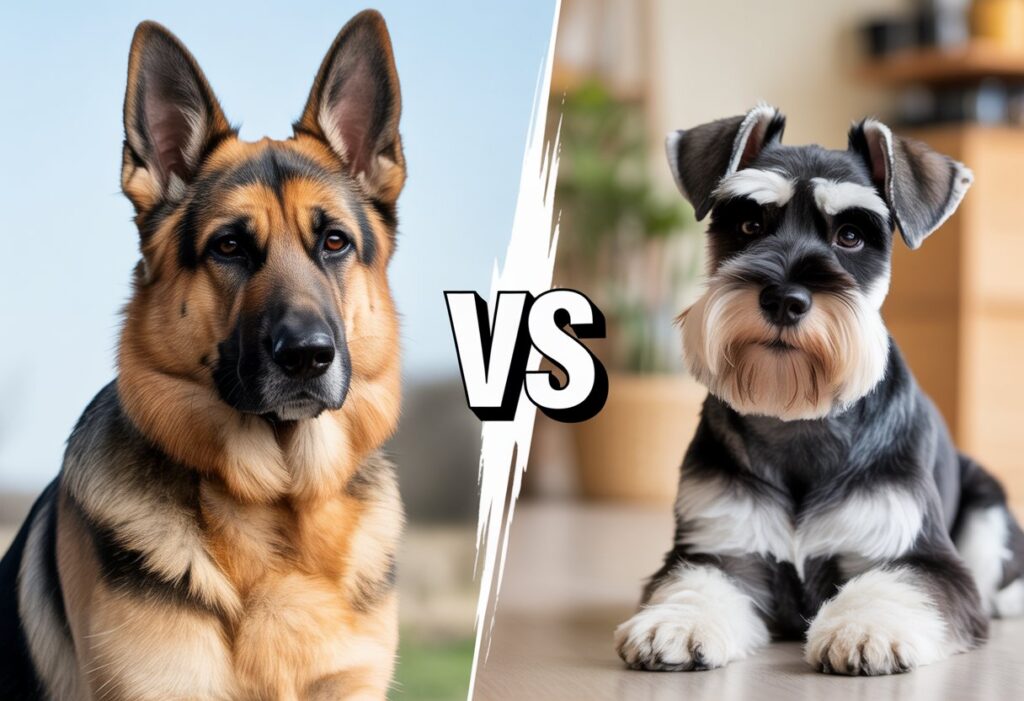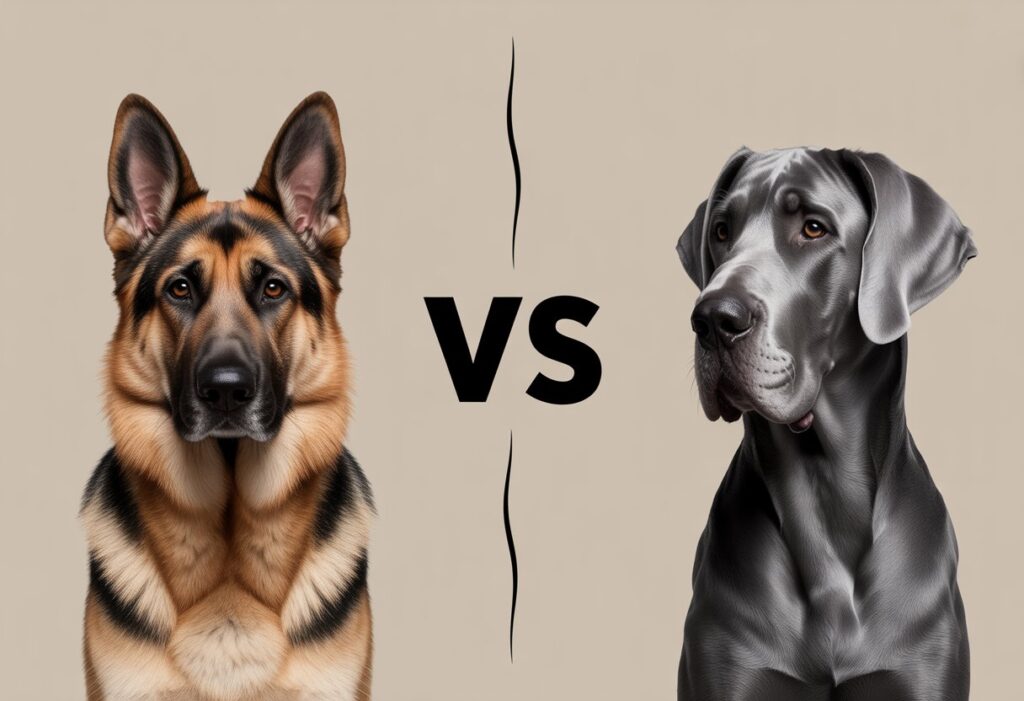Are you thinking about getting a German Shepherd or a Miniature Schnauzer? These two breeds have big differences in size, personality, and care needs.
That can really affect your decision. Knowing what sets these dogs apart will help you pick the right fit for your lifestyle and family.
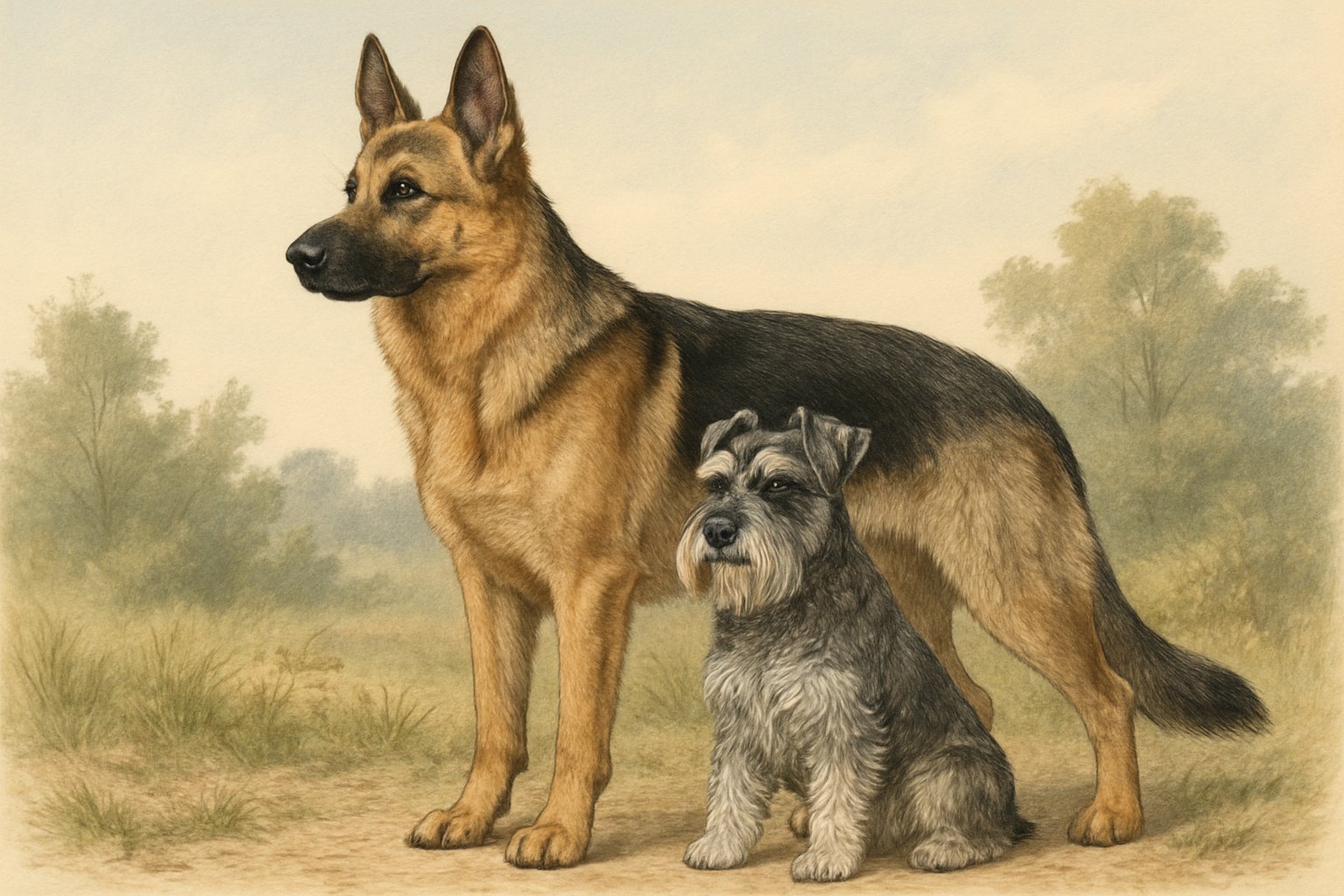
Both the German Shepherd and Miniature Schnauzer are smart, loyal, and active. Still, their backgrounds and traits shape how they behave.
You’ll find out how each breed handles training, gets along with people, and fits into different living spaces.
Key Takeaways
- Each breed has a unique history and appearance.
- Temperament and energy levels make a big difference in daily life.
- Health needs and care routines vary between these two dogs.
Breed Origins and History
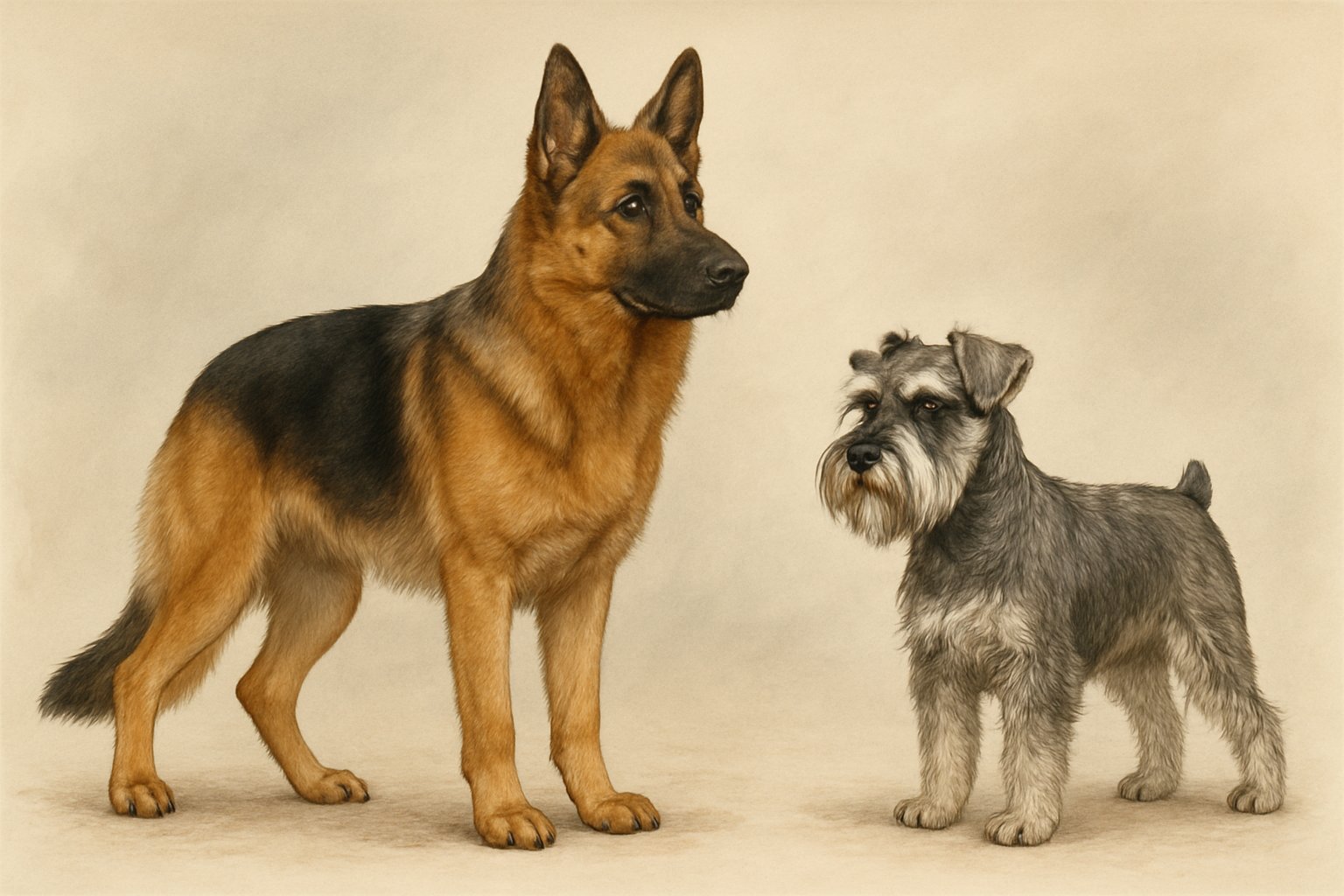
Both the German Shepherd and Miniature Schnauzer have unique origins shaped by their roles as working dogs in different parts of Europe. Their histories influence their looks and temperaments.
Development of the German Shepherd
The German Shepherd is a German dog breed created in the late 1800s. Captain Max von Stephanitz wanted to develop the ideal herding dog by mixing traits from several local sheepdogs.
He picked a dog named Horand von Grafrath as the first registered German Shepherd. The breed caught on quickly for its versatility.
German Shepherds took on roles as police, military, and service dogs because of their strength and trainability. Today, the American Kennel Club (AKC) lists the German Shepherd as one of the most popular and respected purebreds.
Their working background still shapes their behaviors and needs.
Background of the Miniature Schnauzer
The Miniature Schnauzer also comes from Germany, developed in the late 1800s. Breeders crossed the Standard Schnauzer with smaller breeds like the Affenpinscher and Poodle.
They wanted a small dog that could hunt rats and serve as a watchdog on the farm. Unlike their bigger cousins, the Standard and Giant Schnauzers, Minis were bred mostly for companionship and pest control.
The Miniature Schnauzer stands out with its bushy beard and eyebrows. The AKC now recognizes it as a distinct breed with its own standard.
Its confident and alert personality still reflects its German roots.
Breed Standards and Recognition
Breed standards are detailed guidelines set by groups like the AKC. These describe how each breed should look and act.
For German Shepherds, the standards cover their upright ears, smart gaze, and strong, balanced bodies. The Miniature Schnauzer’s standard mentions its square build, wiry coat, and signature facial hair.
Both breeds must meet health, size, and temperament requirements to compete as purebreds. The AKC recognizes both breeds and provides clear guidelines to help breeders and owners.
Physical Characteristics and Appearance
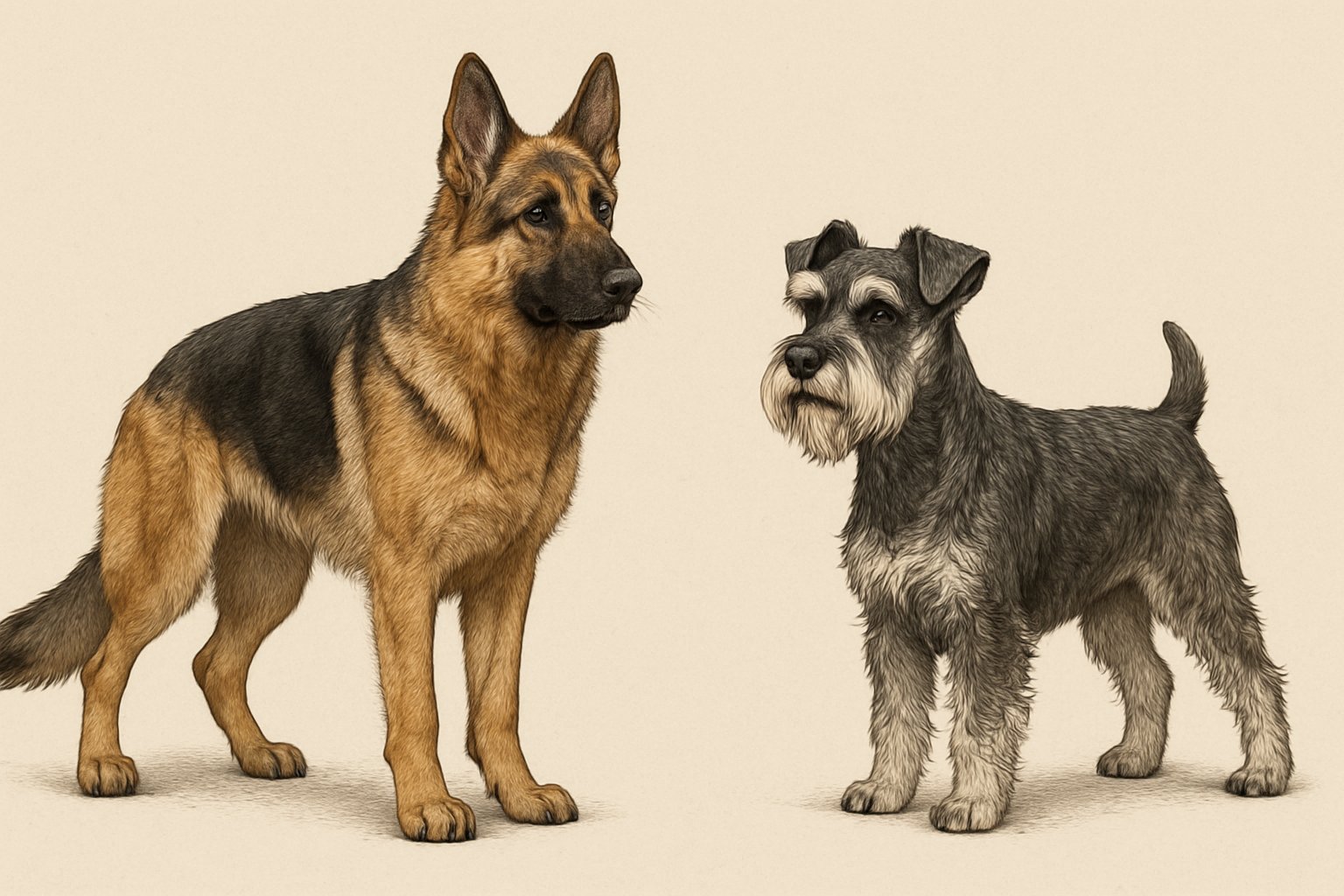
German Shepherds and Miniature Schnauzers each have unique features. You can spot them by their size, build, coat style, and color patterns.
Size and Build Comparison
German Shepherds are much bigger than Miniature Schnauzers. A typical German Shepherd stands 22–26 inches tall at the shoulder and weighs 50–90 pounds.
Their bodies are strong, muscular, and balanced. They’re built for work and agility.
Miniature Schnauzers usually stand 12–14 inches tall and weigh 11–20 pounds. They’re small, compact, and sturdy, with square proportions.
German Shepherds have a long, sloping back and a bushy tail. Miniature Schnauzers have a short back and, in some places, a docked tail.
Their rectangular head, beard, and eyebrows make them easy to recognize.
Size Chart
| Breed | Height (inches) | Weight (pounds) |
|---|---|---|
| German Shepherd | 22 – 26 | 50 – 90 |
| Miniature Schnauzer | 12 – 14 | 11 – 20 |
Distinctive Appearance and Coat Types
You’ll notice clear differences in how these breeds look. German Shepherds have a double coat, with a dense undercoat and a medium-length, straight outer coat.
Some have a slightly longer coat, but heavy feathering is rare. Miniature Schnauzers also have a double coat, but the outer layer feels wiry and the undercoat is soft.
Their beard and bushy eyebrows give them a look you won’t mistake for anything else. German Shepherds have a longer, sleeker muzzle and tall, upright ears.
Miniature Schnauzers have a shorter, stronger muzzle, and their ears might stand up or flop over. The facial hair on Schnauzers really adds to their expressive look.
Common Color Variations
German Shepherds are usually black and tan, but you’ll also see sable, all black, red and black, or even white (though some breed standards don’t allow white). Their markings are clear, with the classic saddle and mask.
Miniature Schnauzers come in a more limited set of colors:
- Salt and Pepper
- Black
- Black and Silver
You pretty much never see a brown or tan Miniature Schnauzer. Their coat color is solid or made up of banded hairs, with less dramatic markings than German Shepherds.
Both breeds keep their unique look as adults. Their coat colors don’t change much as they grow, so you’ll know what to expect.
Temperament and Intelligence
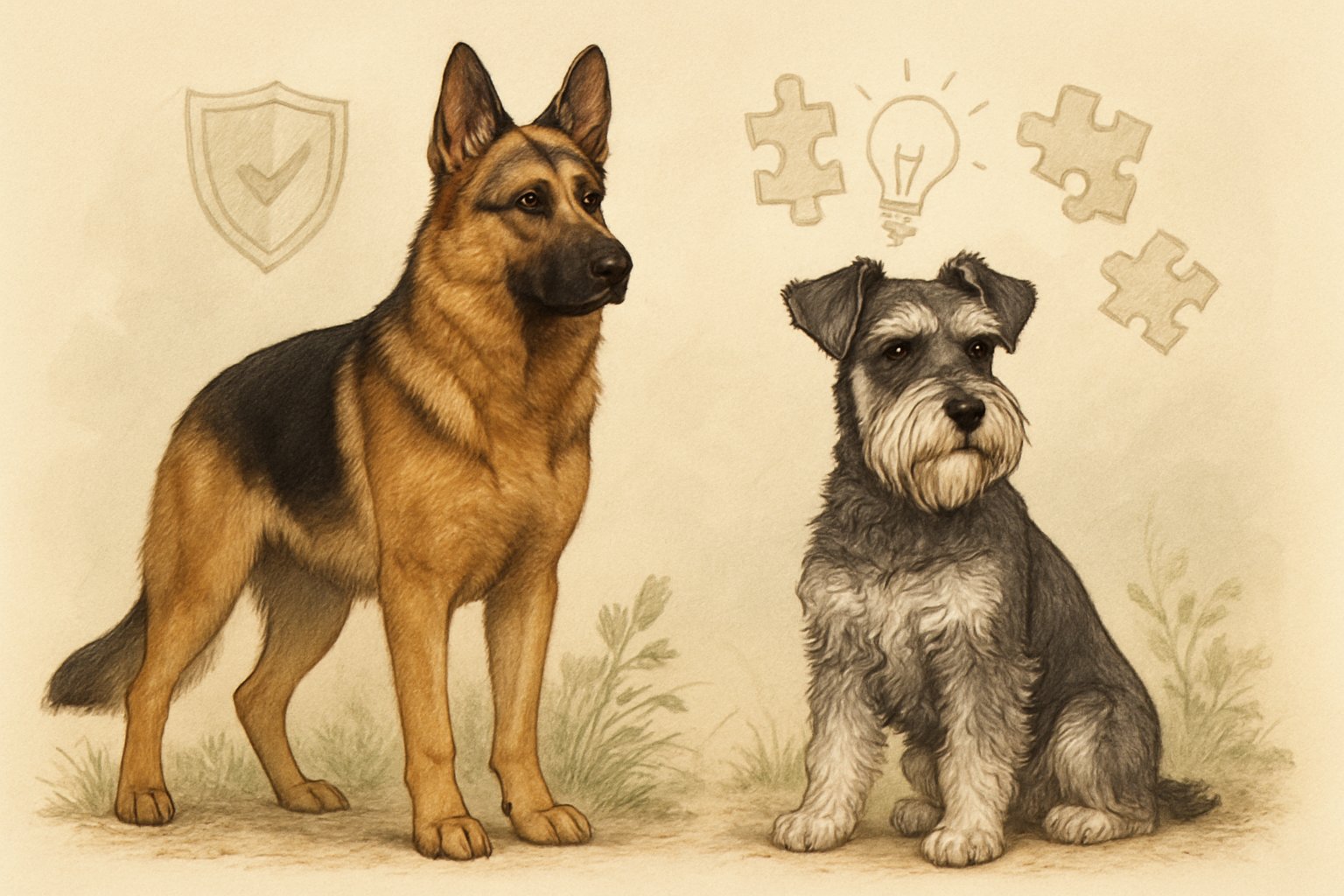
German Shepherds and Miniature Schnauzers both have big personalities. They’re known for being intelligent and loyal, but each has its own quirks and training needs.
Personality Traits
German Shepherds come across as confident, brave, and calm. They’re natural protectors and take their job as a guard dog seriously.
Usually, they’re wary of strangers but very loving with their family. Miniature Schnauzers are more lively and playful.
They’re friendly but can be pretty vocal, which actually makes them good watchdogs for their size. Schnauzers form strong bonds with their people and love being part of family life.
Both breeds can get stubborn if you don’t set clear rules. German Shepherds tend to be more reserved, while Miniature Schnauzers love attention and being in the mix.
Intelligence and Trainability
German Shepherds rank high on the list of smartest dog breeds. They learn quickly and excel at tasks that need focus and discipline, like police or service work.
Their intelligence means they need regular mental challenges and structured training. Miniature Schnauzers are smart too, but they’re a bit more independent.
They pick up tricks fast and love puzzle games, though sometimes they’ll test your limits. Training matters for both breeds.
German Shepherds usually respond well to firm, consistent guidance. Miniature Schnauzers do better with short, playful lessons to keep things interesting.
Both breeds enjoy advanced obedience or agility activities.
Suitability as Family Dogs
German Shepherds make great family dogs if you socialize them early. They’re gentle with kids and protective of their home.
Because of their guarding instinct, they need training to help them tell friend from stranger. Miniature Schnauzers also tend to be good with kids and other pets.
Their smaller size makes them easier to manage in apartments or smaller homes. Schnauzers adapt well to different family situations and want to be close to their people.
Both breeds will let you know if someone’s at the door or if something’s up. If you want a loving family dog that also acts as a protector, either breed could work.
Exercise Needs and Training Requirements
German Shepherds and Miniature Schnauzers have different exercise and training needs. Your daily routine and family lifestyle really matter when picking between these two.
Energy Levels and Activity Needs
German Shepherds are high-energy, much like working breeds such as the Border Collie or Labrador Retriever. They were bred for herding and guarding, so they need at least 1-2 hours of solid activity every day.
Long walks, jogging, hiking, or sports like agility and obedience trials all work. Miniature Schnauzers have plenty of energy too, but they don’t need as much exercise.
About 45-60 minutes of activity each day keeps them happy. Play sessions, short walks, or games in the yard are enough.
They like a mix of mental and physical exercise, but they can handle apartment life better than a big, intense German Shepherd. Puppies from both breeds need shorter, more frequent play sessions until they grow up.
| Breed | Daily Exercise Need | Suitable Activities |
|---|---|---|
| German Shepherd | 1-2 hours | Running, herding games, hiking |
| Miniature Schnauzer | 45-60 minutes | Walks, play, fetch, light hikes |
Socialization and Obedience Training
Training is key for both breeds, but it’s especially important for a strong, confident dog like the German Shepherd. They learn fast and want to work, kind of like Dobermans or Golden Retrievers.
Consistent training helps prevent behavior problems and keeps them safe. Miniature Schnauzers are curious and alert, with a bit of independence like a Beagle.
Early socialization helps keep them from getting too suspicious or noisy with strangers. Both breeds do well with positive reinforcement such as treats and praise.
For the best results, start socialization and obedience classes when your puppy is around 8 weeks to 4 months old. Introducing your dog to people, other dogs, and new places early helps prevent fear and aggression later.
Short, daily sessions work best, especially for puppies with short attention spans.
Health and Lifespan
German Shepherds and Miniature Schnauzers have some big differences in health and lifespan. Some health issues show up in both breeds, but others are more breed-specific.
Common Health Issues
German Shepherds can have allergies, skin problems, and digestive issues. As they get older, they may develop heart conditions, epilepsy, or degenerative myelopathy.
Miniature Schnauzers often deal with diabetes, pancreatitis, and urinary stones. Their double-layer coat sometimes leads to skin issues.
Some Miniature Schnauzers also have eye problems like cataracts or progressive retinal atrophy.
Other breeds have their own health challenges:
- Basset Hounds: Ear infections, obesity
- Pugs: Breathing problems, eye injuries
- Bernese Mountain Dogs: Cancer, joint problems
- Mastiffs and Great Danes: Bloat, joint disorders
Regular vet visits and preventive care help manage these risks.
Hip Dysplasia
Hip dysplasia worries a lot of dog owners, especially if they have bigger breeds like German Shepherds.
German Shepherds often inherit hip dysplasia. The hip joint just doesn’t fit quite right, which leads to pain, arthritis, and trouble walking. It can show up when they’re young and tends to get worse as they age.
Miniature Schnauzers aren’t as likely to get hip dysplasia, but it’s not unheard of. The odds are lower than with big dogs, but you can’t rule it out.
Mastiffs, Great Danes, and Bernese Mountain Dogs really struggle with this issue, mostly because they grow so fast. If your dog falls into a higher-risk group, early screenings and keeping their weight in check can help. Some people swear by joint supplements too, though results can vary.
Expected Lifespan
Miniature Schnauzers usually stick around longer than German Shepherds. With good care, they often reach 12-15 years.
German Shepherds have a shorter run, typically 9-13 years. Joint troubles, heart disease, and cancer pop up more often and can cut things short.
For comparison:
- Great Danes and Mastiffs: 6-10 years
- Bernese Mountain Dogs: 7-10 years
- Basset Hounds: 10-12 years
- Pugs: 12-15 years
Feeding them well, keeping them active, and not skipping checkups all make a difference. It’s not rocket science, but it matters.
Living Environment and Care
Every dog needs regular grooming, a comfy place to call home, and a good vibe with other pets. German Shepherds and Miniature Schnauzers have their own quirks here.
Grooming and Maintenance
German Shepherds shed—a lot. Their double coats need brushing a couple of times a week just to keep up with the hair. When spring or fall hits, you’ll probably end up brushing them every day because of all the shedding.
Miniature Schnauzers barely shed, but their wiry coat isn’t exactly low-maintenance. Plan on brushing them two or three times a week. You’ll also want to give them a trim every month and maybe book a pro groomer every couple of months.
Both breeds need nail trims and ear cleaning. Don’t forget their teeth—brushing two or three times a week helps keep dental issues at bay. For what it’s worth, breeds like the Cavalier King Charles Spaniel and Yorkshire Terrier also need regular brushing, but their hair tangles faster.
Best Home Settings
German Shepherds are big and always moving. They really do best in homes with yards. If you live in an apartment, you’ll have to make up for it with long walks and plenty of playtime.
Miniature Schnauzers fit into smaller spaces pretty easily. Apartments or houses, either works. As long as you give them daily walks and some play, they’re content.
Busy household? Miniature Schnauzers are easier to handle because they’re smaller. German Shepherds love being in the middle of things but need a steady routine to stay chill. Some breeds, like Shetland Sheepdogs or Chow Chows, also need space and exercise, but they might keep to themselves a bit more.
Compatibility With Other Pets
German Shepherds can get along well with other pets, especially if you socialize them early. They’re often gentle with family cats or smaller dogs when they’ve grown up together.
Sometimes, their herding instincts kick in and they’ll chase or try to “herd” other pets. That’s just part of their nature.
Miniature Schnauzers come off as alert and friendly, but they can get a bit territorial. If you put in the work to socialize them, they usually accept other household pets, including cats and small dogs like Yorkshire Terriers.
Some Schnauzers might bark at new animals at first. Give them a little time and most will settle down after they get used to the newcomer.
Shetland Sheepdogs and Cavalier King Charles Spaniels tend to be gentle with other dogs and cats. On the other hand, a Chow Chow might act more aloof or try to be the boss.
Honestly, early socialization goes a long way with almost any breed if you want a peaceful multi-pet home.

